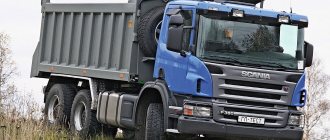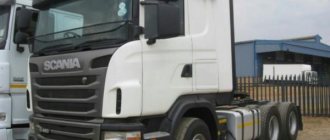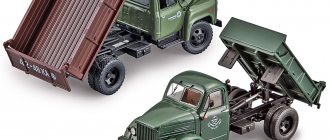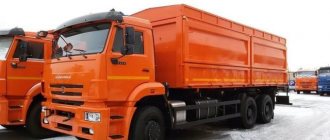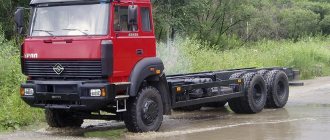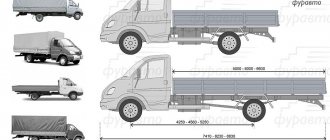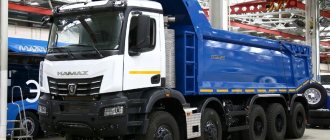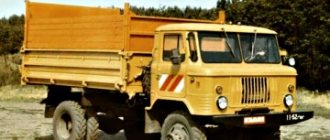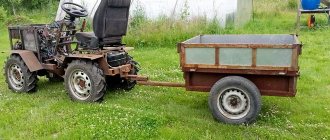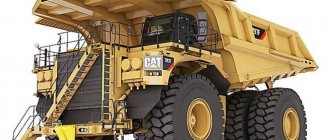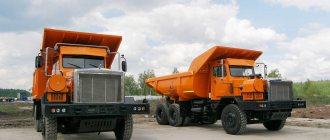First agricultural (Part 1)
Mikhail Sokolov Photos from the funds of the RGANTD branch (Samara) and the author’s archive
Part 1 Part 2
Remembering one of the most common domestic dump trucks of the 1950–1960s. – ZIS(ZIL)-MMZ-585, its most common modifications are usually called: construction “585V”, “585I” and “585L” or agricultural “585E”, “585K” and “585M”. All of them were equipped with all-metal bodies traditional for dump trucks. However, among this list of modifications of the “five hundred cheerful”, as the ZIS-MMZ-585 was popularly called, as a rule, there is no one almost unknown to anyone, but at the same time not only existing in prototypes, but also once produced quite serially “out of the ordinary” exiting dump truck with a wooden-metal body.
What kind of dump truck do you need?
As you know, the ZIS-585 dump truck was created at Defense Plant No. 40, known as the Mytishchi Machine-Building Plant (MMZ) after the end of the war, in order to fill the huge shortage of dump trucks needed for the construction and restoration of industry. As for agriculture, even with the development of mass production of domestic GAZ-93, ZIS-585 and MAZ-205 dump trucks, trucks with tipping bodies were still practically absent in this industry. Only emerged in the early 1950s. Difficulties with food and the need to sharply increase agricultural production forced the leadership of the USSR to pay attention to equipping agriculture with specialized vehicles. The fact is that it required its own, special dump trucks. To the question “which ones exactly?” A quote from an article by engineer I. Pokrovsky “dump trucks for transporting agricultural goods”, published in the magazine “Automobile Transport”, No. 2, 1954, answers well:
“Vehicle designs must ensure maximum use of carrying capacity when transporting bulk agricultural cargo (which, as is known, is lighter than industrial and construction cargo), bulk transportation of grain, cargo safety, and mechanized unloading. The cars currently produced by our car factories do not fully satisfy these requirements. Flatbed vehicles do not allow mechanized unloading. When transporting agricultural goods in standard dump trucks with metal platforms, the utilization rate of the vehicles' carrying capacity, due to the small capacity of the bodies, is very low. Some goods are not recommended to be transported in metal platforms at all. The designs of onboard vehicles and standard dump trucks do not adequately ensure bulk transportation of grain and safety of cargo during transportation. The capacity of metal dump truck platforms can be increased, but this is associated with the additional expenditure of a significant amount of metal, which will result in a corresponding increase in the weight of the body and a decrease in the load-carrying capacity of the vehicles. Thus, the need to create specialized vehicles for agriculture, the designs of which will meet the above requirements, is obvious.”
As a result, the USSR began the development of dump trucks with more sealed bodies of increased volume, specifically designed for bulk transportation and mechanized unloading of grain, other basic agricultural products, mineral fertilizers, etc. The very first domestic agricultural dump truck was the ZIS-585 modification, created in Mytishchi in the spring of 1952, with a wooden-metal body with a volume of 4.42 m3 (in contrast to the standard “585” body with a volume of only 2.4 m3).
Experienced "farmer"
At that time, Mytishchi dump trucks were even officially called simply ZIS-585 and ZIS-585V, and the second abbreviation - MMZ - began to be added to the first only in 1957. By the end of 1952, a similar dump truck based on the GAZ-93 appeared with a smaller version of this or a wooden-metal body. Later, both models were mass-produced, but in this regard, the GAZ car was much more fortunate (article “Wooden GAZ-93”). As for the dump trucks produced by MMZ, paradoxically, but after many years, the experimental version of the agricultural “585” turned out to be more famous, which in the documents of the Ministry of Road Transport and NAMI was designated as “ZIS-585 with a wooden-metal body” , without having any name of its own, although in the factory documentation it had the index “ZIS-585-сх”, where the last two letters stood, of course, as “agricultural”.
Prototypes of the ZIS-585 with a wooden-metal body were manufactured on the basis of a serial dump truck with an all-metal platform, which in turn was based on the standard “dump” chassis ZIS-120G. In the surviving photographs there are at least two different copies of this car, differing in the side sides of the body and license plates, although the possibility that it was the same sample, simply redone during the testing process, cannot be completely ruled out. The most detailed information about this experimental model ZIS-585 with a wooden-metal body is contained in the same article by engineer I. Pokrovsky “Dump trucks for transporting agricultural goods” (“Automobile transport”, No. 2, 1954):
“One of the types of vehicles that provide mechanized unloading and at the same time meet the requirements of agricultural production is a dump truck with a wood-metal platform. The design of such a dump truck was carried out in 1952 by the Mytishchi Machine-Building Plant on the basis of a standard ZIS-585 dump truck. Later, a similar design was made on the basis of the GAZ-93 dump truck by the Odessa Automobile Assembly Plant. The new dump trucks retain all the units and components of standard ZIS-585 and GAZ-93 vehicles, in particular, the lift and the drive to it. Only the metal platform has been replaced by a wooden-metal one, the floor and sides of which are made of wood, and the base, side posts and the mechanism that locks the tailgate are made of metal.
The capacity of the wooden-metal platform of the ZIS-585 dump truck is 4.42 m3 (onboard 3IS-150 - 4.91 m3)... Wooden-metal platforms are made very dense, thanks to which they can transport grain without containers. There is a rubber seal between the opening tailgate, the side walls and the floor. The tailgate is secured with hinged locks and can be opened at the bottom and at the top; in the first case - like a standard dump truck, in the second - like a regular on-board vehicle.
The maximum platform elevation angle is fixed automatically. It falls under its own weight. To do this, the driver only needs to move the lever located in the cab. The tailgate at the bottom is unlocked and locked by the driver from the car's step using a lever device. The driver must leave the cab only to open and close the side at the top.
To better preserve the cargo transported in the dump truck and protect it from rain, snow and wind, the platform design includes a wooden folding roof. The roof of the ZIS-585 dump truck consists of eight... interconnecting flaps. The front and rear doors are tightly attached to the sides of the platform; the remaining doors can “gather” to the front and rear sides, overlapping one another.”
It is interesting that the rear side of the dump truck was not strictly vertical, but beveled, that is, it had a slight slope of the upper part somewhat forward. This was done, apparently, for a better fit of the side when closing and fixing it.
Trials of labor
Prototypes of the ZIS-585 dump truck with a wooden-metal platform from July 1952 to May 1953 underwent operational tests in Moscow at NAMI, in Solnechnogorsk at the Central Machine Testing Station (CMIS) of the Ministry of Agriculture and in Yaroslavl at the plant -mill No. 6. During these tests, dump trucks transported wheat, oats, potatoes, peat, mineral fertilizers, manure, gravel, etc. In Moscow, cars transported grain from the grain base to mills, and carried peat for the green planting trust in the Timiryazevsky district of the capital. The load of the ZIS-585 dump truck samples with wooden-metal platforms, depending on the type of cargo, ranged from 2500 to 3500 kg.
It is interesting that the amount of metal additionally consumed for the manufacture of the ZIS-585 dump truck compared to the onboard ZIS-150 was about 850–900 kg; while for a dump truck with a wooden-metal body – only 400–450 kg. In particular, out of 620 kg of the total weight of the wooden-metal body of the ZIS-585-skh, the share of metal parts accounted for only 240-260 kg, while the standard all-metal body was twice as heavy. During mass production of the ZIS-585-skh, this promised significant savings in metal.
But let’s return to testing, or rather to trial operation.
During its period, ZIS-585-skh dump trucks transported 2,160 tons of cargo, performed 640 unloading operations with a total mileage of 16 thousand 150 km. Cars were tested in most cases on roads of lower categories (country roads) under different weather and temperature conditions. Technical characteristics of the experimental ZIS-585-skh (according to the NAMI test report)
| Load capacity | 3500 kg |
| Curb weight without roof | 4465 kg |
| Platform weight without roof | 620 kg |
| Roof weight with fastening parts and locks | 160 kg |
| Overall width (over the body) | 2444 mm |
| Overall height (without load) | 2180 mm |
| Kitchen volume | 4.42 m3 |
Overall dimensions of the platform:
| 2823 mm 2236 mm 700 mm |
Loading height:
| 1931 mm 1231 mm |
| Maximum platform elevation angle | 44° |
| Vehicle height when platform is fully raised without load | 3205 mm |
| Ground clearance to bottom edge of raised platform | 768 mm |
| Distance from tipping axis to tailgate | 650 mm |
| Rear overhang | 1100 mm |
| Rear overhang angle | 51° |
| Platform raising/lowering time | 10–12 s / 10–12 s |
| Lifting mechanism and its drive | hydraulic, standard |
| Platform lift control | a crane controlled by a lever from the driver's cab |
| Maximum driving speed | 65 km/h |
| Fuel consumption | 40 l/100 km |
Maintenance and repair of the wooden-metal platform did not present any particular difficulties. It was easily detached from the hydraulic lift and from the frame. To remove the platform, you must first unscrew ten bolts in the dump truck. Therefore, the bulkhead of the wooden-metal dump truck platform and other repair work could be carried out in any vehicle fleet.
Engine
ZIL-164 is equipped with a carburetor 4-stroke 6-cylinder in-line unit running on gasoline. The compression ratio of the power plant has increased compared to previous models (6.2 instead of the previous 6.0). The cast iron cylinder head was replaced by an aluminum head. Gasoline was supplied forcibly through a sealed fuel pump with a capacity of 60 l/hour.
The combined lubrication system of the power plant included fine and coarse filters located in the same housing. All modifications of the ZIL-164 received upgraded radiator shutters. An updated radiator with an expansion tank and a sealed plug was installed exclusively on tractors.
The car received an MKZ-K-82 carburetor with a pneumatic crankshaft speed regulator.
Characteristics of the ZIL-164 power plant:
— working volume — 5.56 l;
- rated power - 100 hp;
— rotation speed – 2800 rpm;
- maximum torque - 33 kgf/m.
Trouble-free, with some modifications
In general, during the testing period, dump trucks with wooden-metal platforms proved to be reliable and trouble-free in operation, so their designs were assessed positively. They fully met the requirements for bulk transportation of grain and mechanization of unloading work in agriculture. The hydraulic lifts on the 585-skh dump trucks worked no worse than those on the standard 585-s. During the entire test period, oil was added to them only twice and the hydraulic cylinder stuffing box was sealed once. Possible repairs to subframe and hydraulic cylinder parts did not differ from repairs carried out on conventional dump trucks and did not cause any difficulties.
The performance qualities of wood-metal bodies were considered satisfactory. Their wood retained its original density, no cracks or crevices were observed. And this despite the fact that the dump trucks were stored for 10 months without a garage, exposed to precipitation and sunlight, and operated in difficult road conditions, so that their platforms underwent increased force impacts. The bodies of these dump trucks retained all the advantages of wooden platforms of flatbed vehicles, and thanks to the lift, they were in no way inferior to standard dump trucks in terms of mechanization of unloading work. In addition, wooden-metal bodies were distinguished by enviable ease of repair, requiring no welding or other skilled work, which was important in the conditions of the then collective farm workshops and poorly equipped MTS.
Tests have shown that the use of dump trucks with wooden-metal bodies in agriculture has helped to increase vehicle productivity and reduce transportation costs. The design of these dump trucks with bodies of increased volume made it possible to make maximum use of the chassis' carrying capacity when transporting the most massive agricultural cargo. And most importantly, if unloading grain from an onboard ZIS-150, which was carried out by two or three people, took 20–25 minutes, then unloading grain with a dump truck was carried out in one minute without the help of loaders. In addition, when transporting grain in flatbed vehicles, an accompanying person was required. The bodies of dump trucks with wooden-metal platforms could be locked and sealed, so there was no need to accompany the cargo.
However, at the same time, during the testing of dump trucks with wooden-metal bodies, some of their design and manufacturing shortcomings were also identified. The metal racks of the side boards (box-shaped section) turned out to be insufficiently strong, which gradually bent, unable to withstand the loads, which is why by the end of the tests the side boards in the central part “diverged” somewhat outward. This was especially true for the model with three racks, so subsequently the version with four racks was chosen for mass production as it was more reliable.
The folding roof also caused criticism. Due to the leakage at the junction of the sashes, it did not fully protect the transported cargo from rain. In addition, the roof was clearly weighted. As a result, it was recommended to lighten it, and at the same time install seals between the sashes. In addition, tests showed that in most cases the roof was not used at all when transporting goods. Therefore, it seemed advisable to completely abandon such roofs on most agricultural dump trucks, and equip them with only certain batches of these vehicles produced on special orders.
The lever arrangement of the upper tailgate locks also turned out to be not quite strong. Poor configuration of the chain hooks for hanging the tailgate was noted (sometimes these hooks popped out while driving). The need for some increase in body capacity was identified.
Part 1 Part 2
Device
ZIL-164 received a riveted stamped frame, consisting of two beams with a channel section, which were connected by a steel cross member. The longitudinal beams had a variable cross-section in width and height. Tow hooks and the front bumper were bolted to them. On the first modifications of the truck, a U-shaped bumper was installed. The front cross member was used to mount the radiator and front engine mount. The rear supports of the unit were attached to the front beam from the inside.
The front axle had a suspension with two springs, the rear axle had a suspension with two additional and two main springs, suspended on the frame by means of semi-elliptical springs connected to the rear axle and the front axle.
